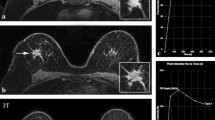Abstract
Background
Breast MRI protocols have been improved by using a combination of dynamic scans for bilateral breasts and high-resolution imaging for a single breast which can be obtained during dynamic scans by recent technological advances. The purpose of this study was to compare high-resolution imaging during dynamic scans (HR-intra) with high-resolution imaging obtained post dynamic scans (HR-post).
Methods
Fifty-five women with pathologically proven breast cancer who underwent breast dynamic scans at 3-T MRI from February to September 2009 were enrolled in this study. Tumoral contrasts to the background breast tissue were compared by three radiologists independently in a blinded fashion. Results of visual assessment were categorized into three groups as follows: HR-intra being better (IB), equal (E), and HR-post being better (PB). The contrast to noise ratio (CNR) of the tumor and the signal to noise ratio of the normal breast gland (SNR) were compared between HR-intra and HR-post.
Results
Two patients were excluded because of poor MR imaging quality. Three radiologists separately categorized 64.2, 79.2, and 77.4 % of lesions as IB. The CNR of the tumor of HR-intra (mean ± SD = 6.9 ± 4.0) was significantly higher than that of HR-post (6.0 ± 3.7, p < 0.0001). The SNR of the normal breast gland of HR-intra (9.5 ± 1.7) was significantly lower than that of HR-post (10.0 ± 1.9, p < 0.0001).
Conclusion
HR-intra during dynamic MRI provided earlier and better tumor to normal breast gland contrast than HR-post.






Similar content being viewed by others
References
Kuhl C. The current status of breast MR imaging. Part I. Choice of technique, image interpretation, diagnostic accuracy, and transfer to clinical practice. Radiology. 2007;244:356–78.
Mann RM, Kuhl CK, Kinkel K, Boetes C. Breast MRI: guidelines from the European Society of Breast Imaging. Eur Radiol. 2008;18:1307–18.
Uematsu T, Kasami M. High-spatial-resolution 3-T breast MRI of nonmass like enhancement lesions: an analysis of their features as significant predictors of malignancy. AJR Am J Roentgenol. 2012;198:1223–30.
Uematsu T, Kasami M, Yuen S, Igarashi T, Nasu H. Comparison of 3- and 1.5-T dynamic breast MRI for visualization of spiculated masses previously identified using mammography. AJR Am J Roentgenol. 2012;198:W611–7.
Cubuk R, Tasali N, Narin B, Keskiner F, Celik L, Guney S. Correlation between breast density in mammography and background enhancement in MR mammography. Radiol Med. 2010;115:434–41.
Uematsu T, Kasami M, Watanabe J. Background enhancement of mammary glandular tissue on breast dynamic MRI: imaging features and effect on assessment of breast cancer extent. Breast Cancer. 2012;19:259–65.
American College of Radiology. ACR practice guideline for the performance of contrast enhanced magnetic resonance imaging (MRI) of the breast. ACR. 2013. http://www.acr.org/~/media/ACR/Documents/PGTS/guidelines/MRI_Breast.pdf. Accessed 17 Aug 2013.
American College of Radiology. Breast Imaging Reporting and Data System (BI-RADS). 4th ed. Reston: American College of Radiology; 2003.
Tozaki M. Diagnosis of breast cancer: MDCT versus MRI. Breast Cancer. 2008;15:205–11.
Schnall MD, Blume J, Bluemke DA, et al. Diagnostic architectural and dynamic features at breast MR imaging: multicenter study. Radiology. 2006;238:42–53.
Kuhl CK, Mielcareck P, Klaschik S, et al. Dynamic breast MR imaging: are signal intensity time course data useful for differential diagnosis of enhancing lesions? Radiology. 1999;211:101–10.
Conflict of interest
All authors have no conflict of interest to disclose.
Author information
Authors and Affiliations
Corresponding author
About this article
Cite this article
Kato, F., Oyama-Manabe, N., Sakuhara, Y. et al. Earlier and better high-resolution single breast imaging during bilateral breast dynamic scans at 3-T MRI: comparison with post dynamic high-resolution imaging. Breast Cancer 22, 475–479 (2015). https://doi.org/10.1007/s12282-013-0505-z
Received:
Accepted:
Published:
Issue Date:
DOI: https://doi.org/10.1007/s12282-013-0505-z




